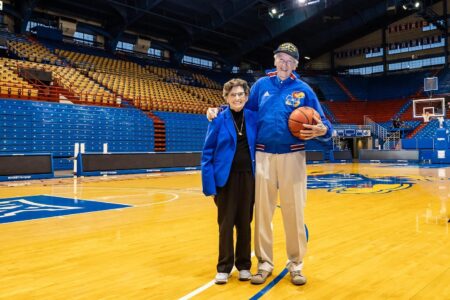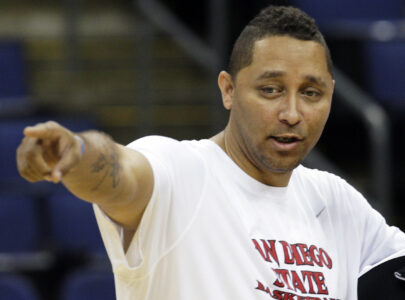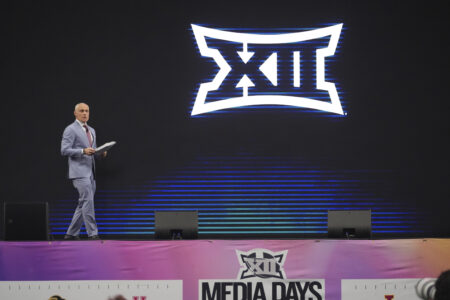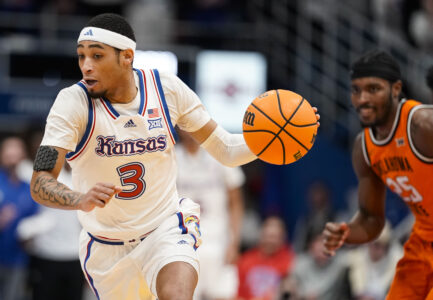What to make of KU’s slower start to portal season

Kansas head coach Bill Self looks down his bench late in the second half, Thursday, March 20, 2025 at Amica Mutual Pavilion in Providence, RI. The Jayhawks lost to the Razorbacks 79-72. Photo by Nick Krug
Assuming all six of the Kansas men’s basketball team’s rapid-fire offseason departures — in the span of a week, Zach Clemence, Flory Bidunga, Rakease Passmore, David Coit, Rylan Griffen and AJ Storr — stay in the transfer portal and go elsewhere, KU will return zero scholarship players who played during the 2024-25 season.
That’s an unprecedented situation for Bill Self and his coaching staff.
Sure, the Jayhawks lost an even greater number of players just two offseasons ago, including their entire 2022 recruiting class, but they still had the likes of KJ Adams and Dajuan Harris Jr. hanging around to ensure some level of continuity with the two highly successful teams that preceded that spring.
Now, on the other hand, there is no thread tying KU to, by most metrics, the worst two seasons of Self’s 22-year tenure in Lawrence — and so far no one new coming in from the portal.
For the sake of clarity it must be noted that the Kansas men’s basketball roster is not truly a clean slate. The freshman class of 2023 does in fact still exist. Guards Elmarko Jackson and Jamari McDowell remain in Lawrence and, particularly if Jackson makes a full recovery after tearing his patellar tendon 10 months ago, will likely be much more polished players by the time they return to the court after redshirting.
Bryson Tiller has already been on campus for a semester rehabilitating his long-term ankle injury, and he will soon be joined by classmates Darryn Peterson — who has been busy dazzling Kansas fans, pro scouts and the world at large at the McDonald’s All-American Game and Chipotle Nationals — and Samis Calderon.
Noah Shelby didn’t exactly star at Vanderbilt or Rice after he was a nationally prominent point-guard prospect out of high school, but Shelby, a walk-on last year, is on track to claim another of KU’s 14 roster spots during the 2025-26 season. And then there’s a chance two-sport athlete Jaden Nickens might make his way onto the roster.
But yes — again, if all the portal players actually leave — no one who actually stepped on the James Naismith Court in a game last season will do so next year.
Who will?
How KU is approaching the portal, and some possible reasons why
Self did not necessarily provide as many clues about how he planned to approach the portal this year as he did last season — potentially because there was so much less certainty about what exactly KU would bring back this time around. (Recall that the Jayhawks didn’t lose a single player to the portal after the 2023-24 campaign; the major blows of the offseason were Johnny Furphy going to the draft, Labaron Philon decommitting and Riley Kugel choosing to transfer elsewhere, followed by Jackson’s injury.)
In the wake of KU’s loss to Gonzaga in Salt Lake City in 2024, Self’s message was all about how KU needed shooting, depth and athleticism. The Jayhawks got all those things in theory via Griffen, Storr, Coit, Zeke Mayo and Shakeel Moore.
Just not in reality.
“I’m happy with the roster we had,” Self said last month, after KU lost in the first round of the NCAA Tournament for the first time in 19 years. “It just didn’t turn out to be the team that we had hoped it was.”
Self noted that there was an element of luck involved, but conceded that KU needed to reevaluate its roster-building approach.
So far, KU’s approach, with the second week of the transfer portal winding down, could best (and somewhat generously) be described as a patient one.
The Jayhawks already had Kugel and Mayo in the fold at this stage last offseason.
This time around, KU does not yet have a commitment. It has been at least in the conversation for a number of the top players in the portal — Donovan Dent of New Mexico (No. 4 on 247Sports), Josh Dix of Iowa (No. 13), Keyshawn Hall of UCF (No. 10), Adrian Wooley of Kennesaw State (No. 5) — and has seen them all go elsewhere: to UCLA, Creighton, Auburn and Louisville, respectively.
At least based on the players who have entered thus far, it doesn’t seem like this offseason’s KU transfer class, even with so many spaces available, is going to have a headliner like Storr (a bust in his lone season in Lawrence) or, before him, Hunter Dickinson (as much as he got criticized, still a two-time All-American).
That could be due to any number of factors.
• For one, Peterson himself, as a top-two player in his freshman class, is the guaranteed headliner on next year’s team, no matter who else joins KU from the portal. (His performances in recent days have provided further unshakable evidence of that fact.)
Self has already spoken at length about how Peterson will be at the center of the 2025-26 team and help to define its identity. Virtually no one else KU could conceivably get would be anything better than a secondary option. That might not appeal to players who are used to being the alpha and want to transfer up and take on that role again at a higher level of play.
• It’s also possible, frankly, that KU might have lost just a little bit of its luster as a destination for transfers.
Not so much because the last two seasons have seen KU achieve historical low after historical low — the Jayhawks still won the title three years ago, and historical lows for KU still mean making the tournament with victories over some of the best teams in the nation (even if they also mean being nowhere near competing for another championship, even a conference championship).
Specifically because the Jayhawks’ shortcomings have been in large part due to their struggles to integrate the likes of Storr and Griffen — players with records of success at other prominent programs.
That could scare anyone looking at the Jayhawks, even with as much as Self and his staff accomplished in his first two decades at the helm.
• On the other hand, for a more positive spin, KU could also itself be adopting a choosier approach, selecting players based on its own style rather than acquiring the best available and attempting to tailor them to Self’s system. Trying to shape Storr into a better defender and rebounder, something Self had been discussing openly since June of last year, in order to take his game to new heights simply didn’t work.
Whatever the reason for KU’s patience, other schools are not adopting the same approach.
A momentous Monday
As detailed in robust articles from the Final Four in San Antonio published by Yahoo Sports’ Ross Dellenger and CBS Sports’ Isaac Trotter on Thursday night, most programs across the country have in fact been quite impatient to get deals done in advance of Monday, when Judge Claudia Wilken could make a ruling on the House v. NCAA settlement that will impose a new revenue-sharing model in which schools pay players directly.
Once that model is in place, teams will no longer be able to distribute, via name, image and likeness collectives, the same unregulated money to which they have become accustomed. Instead, their payments will have to fit under a cap of $20.5 million for all sports combined, and any NIL deals for additional money over that cap will be assessed by Deloitte to ensure they match a player’s “fair-market value.” Self recently told ESPN he thought that aspect of the system was good in theory but “it’s hard to imagine how someone can (define) fair market value because to me, the fair market value is what a company or an organization sees that individual’s worth as.”
In any event, price tags have gone way up in what appear to be the final days of the current system. Trotter reports that Dent got more than $3 million from UCLA. Dellenger cited an example of an unnamed player who averaged under 10 points a game and will make $2 million. KU could certainly save money by staying out of those bidding frenzies.
It is also possible that KU believes it is better suited to succeed under the terms of the new model implemented by House. There is reason to think so, particularly when it comes to the NIL component: KU established an in-house marketing initiative FLIGHT, in partnership with Mission-based agency Walz Tetrick, with an eye toward this upcoming fair-market value analysis. In addition, KU Athletics recently contracted Deloitte itself — the same firm operating the NIL clearinghouse — for an analysis of the department’s strategic positioning that would include recommendations on “revenue-sharing, roster caps, walk-ons, sport offerings, NIL implications” and more.
But even if the post-Monday world will treat KU well, the Jayhawks should probably be working to get some contracts signed before then if, as Dellenger writes, cash spent before Monday does not count against the cap of $20.5 million.
It’s a unique offseason — much like every offseason. The way the terms of engagement change in college athletics on a week-by-week basis, let alone year by year, no portal season looks quite like the last one.
This just happens to be a pretty important one for the Jayhawks with Self’s self-described best recruit at KU coming into the fold — not to mention Self’s own time ticking away, as he said in November 2023 he felt he was on the “back three or four” holes of his coaching career before retirement — so even if they are adopting a more targeted approach without swinging for the fences quite as often, they have to find a way to get it exactly right.







